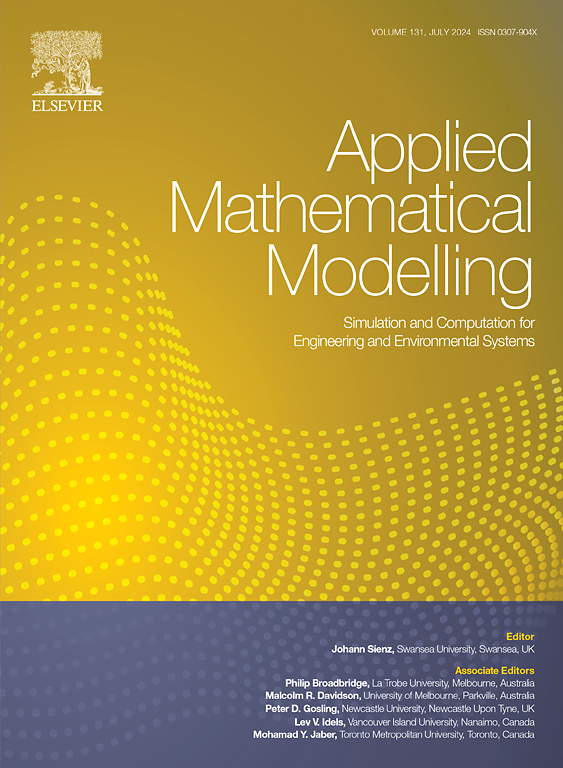症状依赖性SIS群体中病毒毒力的进化入侵模型
IF 4.4
2区 工程技术
Q1 ENGINEERING, MULTIDISCIPLINARY
引用次数: 0
摘要
在传染病传播过程中,病毒的毒力及其演化对传播动力学的影响对公众和决策者具有重要意义。为了揭示病毒毒力进化对种群内传播动力学的影响,我们建立了一个带有病毒毒力的SIS-v耦合模型,其中传播率和致病性死亡率作为病毒毒力的函数。SIS模型和SIS-v模型在症状依赖群体中针对病毒毒力进化的动态分析得到了广泛的探讨。具体地说,利用下一代矩阵法推导了两种模型的基本再现数的表达式,然后利用Routh-Hurwitz准则和LaSalle不变性原理推导了平衡点的存在性和稳定性。利用自适应动力学方法,研究结果表明,当无症状边界平衡点全局渐近稳定时,突变病毒在一定条件下可以入侵有病毒的种群,且全局渐近稳定的病毒毒力是突变病毒入侵适应度和绝对适应度均最大化的进化奇点。当症状边界平衡点全局渐近稳定时,结论是相同的。此外,利用SIS模型和监测数据对病毒毒力进行了数值模拟。结果表明,SARS-CoV-2从野生毒株进化到Delta毒株,再进化到Omicron毒株,毒力逐渐减弱。病毒毒力的增强导致了感染规模的增大。而病毒毒力的降低导致基本繁殖数的下降。随着病毒毒力的增强,突变病毒的入侵适应度呈增加趋势,直至达到最大值。主要研究结果为公众和地方政府决策者应对传染病传播提供了三点重要启示:病毒毒力进化特征有助于公众应对新出现的毒株;当地政府的非药物干预有效降低了重点人群中无症状个体和有症状个体的基本繁殖数;当重点人群为无症状感染者时,当地政府应注重及时开展核酸筛查,防止疫情扩散;当重点人群为有症状个体时,当地政府应加强对有症状个体的隔离措施。本文章由计算机程序翻译,如有差异,请以英文原文为准。
Evolutionary invasion model of the viral virulence in a symptom-dependent SIS community
The impacts of viral virulence and its evolution on transmission dynamics are important for the public and the policymakers during the spread of infectious diseases. To reveal the impacts of viral virulence evolution on transmission dynamics within the population, we formulate a coupled SIS-v model with viral virulence, in which transmission rate and disease-induced death rate are set as functions of viral virulence. The dynamic analysis for SIS model and SIS-v model are extensively explored within the symptom-dependent community against viral virulence evolution. Precisely, the expressions of basic reproduction numbers for two models are derived by the next generation matrix method, the existence and stabilities of equilibrium points are then derived by Routh-Hurwitz criterion and LaSalle's invariance principle. By the adaptive dynamics method, the results reveal that when the asymptomatic boundary equilibrium point is globally asymptotically stable, the mutant virus could invade the population with resident virus under certain conditions, and the globally asymptotically stable viral virulence is the evolutionary singularity that maximizes both the invasion fitness and the absolute fitness for mutant virus. When the symptomatic boundary equilibrium point is globally asymptotically stable, the conclusion is the same. Furthermore, the numerical simulations with respect to viral virulence are performed using SIS model and surveillance data. The corresponding results show that SARS-CoV-2 virulence is relaxed, when the evolution starts from wild strain to Delta strain and further to Omicron strain. The increase of viral virulence contributes to the enhancement of infection scale. While, the decrease of viral virulence contributes to the decline of basic reproduction number. The invasion fitness of mutant virus obeys the increasing tendency with the enhancement of viral virulence, until the invasion fitness reaches the maximum. The main results provide three significant insights for the public and the policymakers of local government to fight against the spread of infectious diseases: the features of viral virulence evolution are helpful to the public against the newly emerging strains; the non-pharmacological interventions of the local government effectively decline basic reproduction number for the asymptomatic individuals and the symptomatic individuals within the key population; when the key population consists of the asymptomatic individuals, the local government should focus on the prompt nucleic acid screening against the spread of epidemic; when the key population consists of the symptomatic individuals, the local government should strengthen isolation measures for the symptomatic individuals.
求助全文
通过发布文献求助,成功后即可免费获取论文全文。
去求助
来源期刊

Applied Mathematical Modelling
数学-工程:综合
CiteScore
9.80
自引率
8.00%
发文量
508
审稿时长
43 days
期刊介绍:
Applied Mathematical Modelling focuses on research related to the mathematical modelling of engineering and environmental processes, manufacturing, and industrial systems. A significant emerging area of research activity involves multiphysics processes, and contributions in this area are particularly encouraged.
This influential publication covers a wide spectrum of subjects including heat transfer, fluid mechanics, CFD, and transport phenomena; solid mechanics and mechanics of metals; electromagnets and MHD; reliability modelling and system optimization; finite volume, finite element, and boundary element procedures; modelling of inventory, industrial, manufacturing and logistics systems for viable decision making; civil engineering systems and structures; mineral and energy resources; relevant software engineering issues associated with CAD and CAE; and materials and metallurgical engineering.
Applied Mathematical Modelling is primarily interested in papers developing increased insights into real-world problems through novel mathematical modelling, novel applications or a combination of these. Papers employing existing numerical techniques must demonstrate sufficient novelty in the solution of practical problems. Papers on fuzzy logic in decision-making or purely financial mathematics are normally not considered. Research on fractional differential equations, bifurcation, and numerical methods needs to include practical examples. Population dynamics must solve realistic scenarios. Papers in the area of logistics and business modelling should demonstrate meaningful managerial insight. Submissions with no real-world application will not be considered.
 求助内容:
求助内容: 应助结果提醒方式:
应助结果提醒方式:


